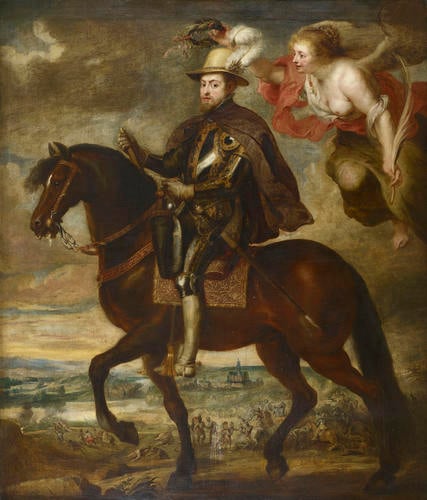-
1 of 253523 objects
Philip II, King of Spain (1527-1598) c.1635
Oil on canvas | 255.9 x 220.3 cm (support, canvas/panel/stretcher external) | RCIN 404392

Studio of Sir Peter Paul Rubens (Siegen 1577 - Antwerp 1640)
Philip II, King of Spain (1527-1598) c.1635
-
This is a good studio version of a posthumous original portrait by Rubens in the Prado, painted during his second stay at the Spanish court (1628-9); the features and armour are based on Titian’s standing portrait of 1551 (also Prado).
The painting celebrates the victory at the siege of the French town of St Quentin in 1557, during the brief period of his rule that Philip II spent in the Low Countries (1555-9). Spanish forces (with English support) fought in the Hapsburg-Valois War (1551-9) against the French to protect the Franco-Netherlandish border. The conflict was resolved at the treaty of Cateaux-Cambrésis (1559); it was here that William of Orange first learned of Philip II’s determination to exterminate heretics within the Low Countries, a policy which lead to revolt, eighty years of war (1568-1648) and the foundation of the Dutch Republic.
The early Hanoverians had a surprising taste for images of Britain’s former enemies: George I bought a portrait he thought to depict the cruel Duke of Alva (CWLF 66, 404393); his grandson, Frederick, Prince of Wales, acquired this image of the man who sent the Armada. There may have been a ‘sub-text’ in these purchases (as well as an enjoyment of Rubens’s flamboyant glamorisation of power): the Hanoverian succession was devised by parliament as a means of ensuring Britain remained free of foreign Catholic tyrants, like Philip II and his henchmen, the Duke of Alva. The message is especially pertinent as Philip II was in fact King of England at the time of the battle of St Quentin, having married Mary I in 1554. Had the couple produced an heir England would have become part of the Hapsburg empire (in fact she died childless in 1558 and Philip's claim vanished).
The painting appears in Pyne's illustrated 'Royal Residences' of 1819, hanging in the Crimson Drawing Room at Buckingham Palace (RCIN 922142).Provenance
Purchased by Frederick, Prince of Wales and hanging in Leicester House by September 1749
-
Creator(s)
Acquirer(s)
-
Medium and techniques
Oil on canvas
Measurements
255.9 x 220.3 cm (support, canvas/panel/stretcher external)
294.8 x 259.5 x 8.5 cm (frame, external)
Category
Object type(s)
Subject(s)
Other number(s)